

Compact Muon Solenoid
LHC, CERN
| CMS-PAS-SMP-22-012 | ||
| Search for the rare decays of the Z and Higgs bosons to a $ \mathrm{J}/\psi $ or $ \psi^{\prime} $ meson and a photon in proton-proton collisions at $ \sqrt{s}= $ 13 TeV | ||
| CMS Collaboration | ||
| 30 November 2023 | ||
| Abstract: A search is performed for the rare decays of the Z and Higgs bosons to a photon and a charmed meson $ \mathrm{J}/\psi $ or $ \psi^{\prime} $, which subsequentially decays to a pair of muons. The data set corresponds to an integrated luminosity of 123 fb$ ^{-1} $ of proton-proton collisions at $ \sqrt{s}= $ 13 TeV collected with the CMS detector at the LHC. The presence of two resonances in the signal is used to discriminate and estimate the non-resonant backgrounds. No evidence for branching fractions to these rare decay channels larger than predicted in the standard model is observed. Upper limits at 95% confidence level are set on $ \mathcal{B}(\mathrm{H}\to\mathrm{J}/\psi\gamma) < 2.6 \times 10^{-4} $, $ \mathcal{B}(\mathrm{H}\to\psi^{\prime}\gamma) < 9.9 \times 10^{-4} $, $ \mathcal{B}(\mathrm{Z}\to\mathrm{J}/\psi\gamma) < 0.6 \times 10^{-6} $ and $ \mathcal{B}(\mathrm{Z}\to\psi^{\prime}\gamma) < 1.3 \times 10^{-6} $. The ratio of the Higgs boson coupling modifiers $ \kappa_{c}/\kappa_{\gamma} $ is constrained to be in the interval $ (-157,+199) $ at 95% confidence level. When assuming $ \kappa_{\gamma}= $ 1, the observed interval becomes $ (-166,+208) $. | ||
| Links: CDS record (PDF) ; Physics Briefing ; CADI line (restricted) ; | ||
| Figures | |

png pdf |
Figure 1:
Leading-order Feynman diagrams of Z and Higgs boson rare decays to $ \psi $ (1S) or $ \psi $ (2S), and a photon, through the direct process (top left) and the indirect processes (top right, bottom left, and bottom right). |
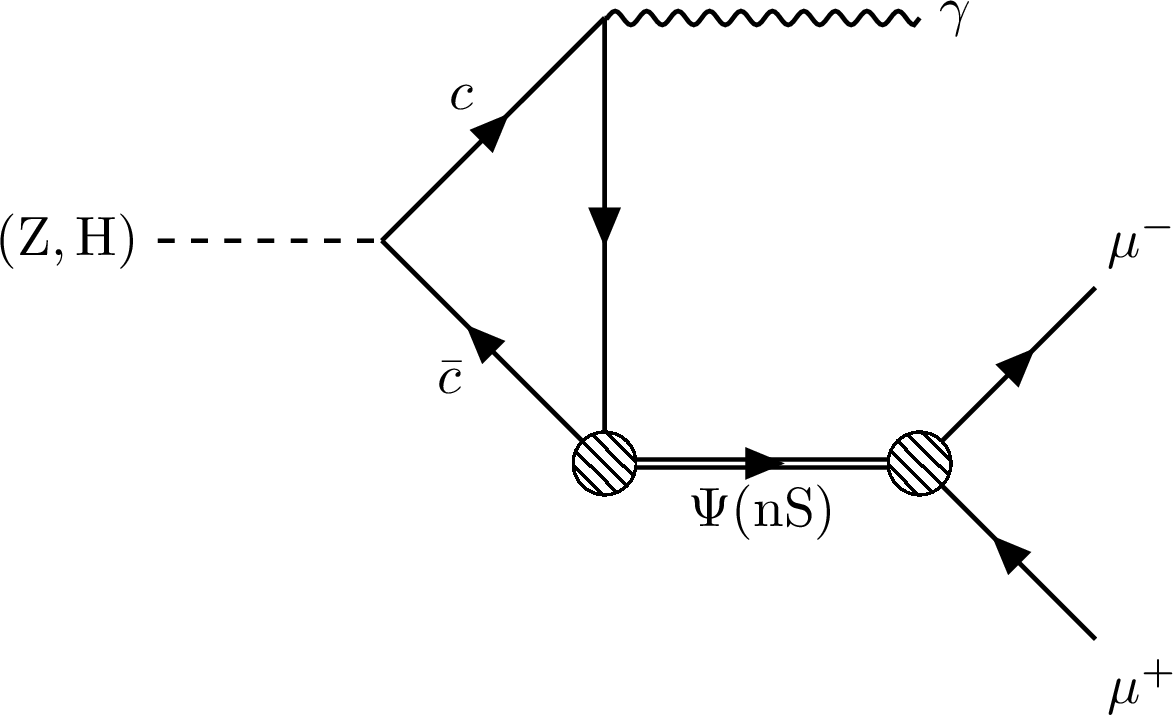
png pdf |
Figure 1-a:
Leading-order Feynman diagrams of Z and Higgs boson rare decays to $ \psi $ (1S) or $ \psi $ (2S), and a photon, through the direct process (top left) and the indirect processes (top right, bottom left, and bottom right). |

png pdf |
Figure 1-b:
Leading-order Feynman diagrams of Z and Higgs boson rare decays to $ \psi $ (1S) or $ \psi $ (2S), and a photon, through the direct process (top left) and the indirect processes (top right, bottom left, and bottom right). |

png pdf |
Figure 1-c:
Leading-order Feynman diagrams of Z and Higgs boson rare decays to $ \psi $ (1S) or $ \psi $ (2S), and a photon, through the direct process (top left) and the indirect processes (top right, bottom left, and bottom right). |

png pdf |
Figure 1-d:
Leading-order Feynman diagrams of Z and Higgs boson rare decays to $ \psi $ (1S) or $ \psi $ (2S), and a photon, through the direct process (top left) and the indirect processes (top right, bottom left, and bottom right). |
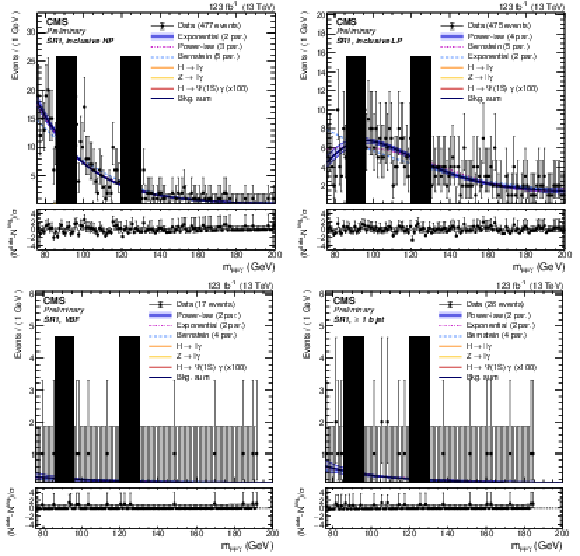
png pdf |
Figure 2:
Background-only fit using the power-law, exponential, and Bernstein polynomial functions with the optimal number of parameters determined with the F-test, and ranked according to the fit $ \chi^2 $. The resonant background contributions are added with normalization fixed to the SM expectation. Top left: $ \mathrm{H}\to\psi $ (1S) $ \gamma $ ggF HP category. Top right: $ \mathrm{H}\to\psi $ (1S) $ \gamma $ ggF LP category. Bottom left: $ \mathrm{H}\to\psi $ (1S) $ \gamma $ VBF category. Bottom right: $ \mathrm{H}\to\psi $ (1S) $ \gamma $ HF category. |

png pdf |
Figure 2-a:
Background-only fit using the power-law, exponential, and Bernstein polynomial functions with the optimal number of parameters determined with the F-test, and ranked according to the fit $ \chi^2 $. The resonant background contributions are added with normalization fixed to the SM expectation. Top left: $ \mathrm{H}\to\psi $ (1S) $ \gamma $ ggF HP category. Top right: $ \mathrm{H}\to\psi $ (1S) $ \gamma $ ggF LP category. Bottom left: $ \mathrm{H}\to\psi $ (1S) $ \gamma $ VBF category. Bottom right: $ \mathrm{H}\to\psi $ (1S) $ \gamma $ HF category. |

png pdf |
Figure 2-b:
Background-only fit using the power-law, exponential, and Bernstein polynomial functions with the optimal number of parameters determined with the F-test, and ranked according to the fit $ \chi^2 $. The resonant background contributions are added with normalization fixed to the SM expectation. Top left: $ \mathrm{H}\to\psi $ (1S) $ \gamma $ ggF HP category. Top right: $ \mathrm{H}\to\psi $ (1S) $ \gamma $ ggF LP category. Bottom left: $ \mathrm{H}\to\psi $ (1S) $ \gamma $ VBF category. Bottom right: $ \mathrm{H}\to\psi $ (1S) $ \gamma $ HF category. |
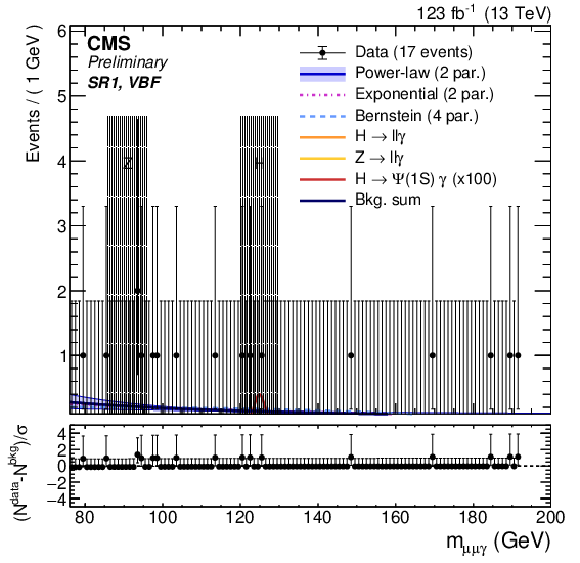
png pdf |
Figure 2-c:
Background-only fit using the power-law, exponential, and Bernstein polynomial functions with the optimal number of parameters determined with the F-test, and ranked according to the fit $ \chi^2 $. The resonant background contributions are added with normalization fixed to the SM expectation. Top left: $ \mathrm{H}\to\psi $ (1S) $ \gamma $ ggF HP category. Top right: $ \mathrm{H}\to\psi $ (1S) $ \gamma $ ggF LP category. Bottom left: $ \mathrm{H}\to\psi $ (1S) $ \gamma $ VBF category. Bottom right: $ \mathrm{H}\to\psi $ (1S) $ \gamma $ HF category. |

png pdf |
Figure 2-d:
Background-only fit using the power-law, exponential, and Bernstein polynomial functions with the optimal number of parameters determined with the F-test, and ranked according to the fit $ \chi^2 $. The resonant background contributions are added with normalization fixed to the SM expectation. Top left: $ \mathrm{H}\to\psi $ (1S) $ \gamma $ ggF HP category. Top right: $ \mathrm{H}\to\psi $ (1S) $ \gamma $ ggF LP category. Bottom left: $ \mathrm{H}\to\psi $ (1S) $ \gamma $ VBF category. Bottom right: $ \mathrm{H}\to\psi $ (1S) $ \gamma $ HF category. |
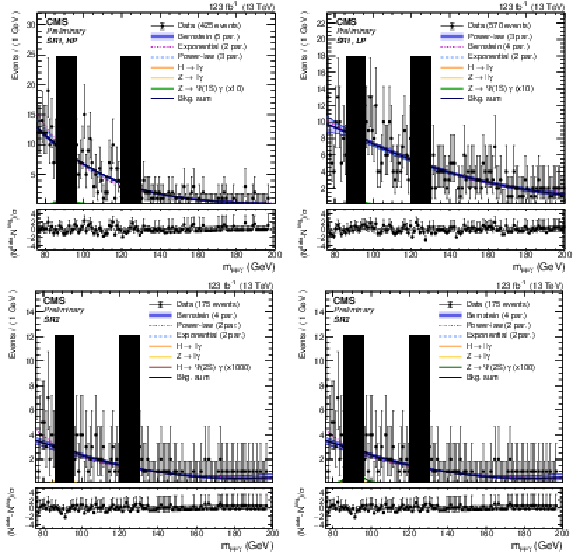
png pdf |
Figure 3:
Background-only fit using the power-law, exponential, and Bernstein polynomial functions with the optimal number of parameters determined with the F-test, and ranked according to the fit $ \chi^2 $. The resonant background contributions are added with normalization fixed to the SM expectation. Top left: $ \mathrm{Z}\to\psi $ (1S) $ \gamma $ HP category. Top right: $ \mathrm{Z}\to\psi $ (1S) $ \gamma $ LP category. Bottom left: $ \mathrm{H}\to\psi $ (2S) $ \gamma $ category. Bottom right: $ \mathrm{Z}\to\psi $ (2S) $ \gamma $ category. |

png pdf |
Figure 3-a:
Background-only fit using the power-law, exponential, and Bernstein polynomial functions with the optimal number of parameters determined with the F-test, and ranked according to the fit $ \chi^2 $. The resonant background contributions are added with normalization fixed to the SM expectation. Top left: $ \mathrm{Z}\to\psi $ (1S) $ \gamma $ HP category. Top right: $ \mathrm{Z}\to\psi $ (1S) $ \gamma $ LP category. Bottom left: $ \mathrm{H}\to\psi $ (2S) $ \gamma $ category. Bottom right: $ \mathrm{Z}\to\psi $ (2S) $ \gamma $ category. |
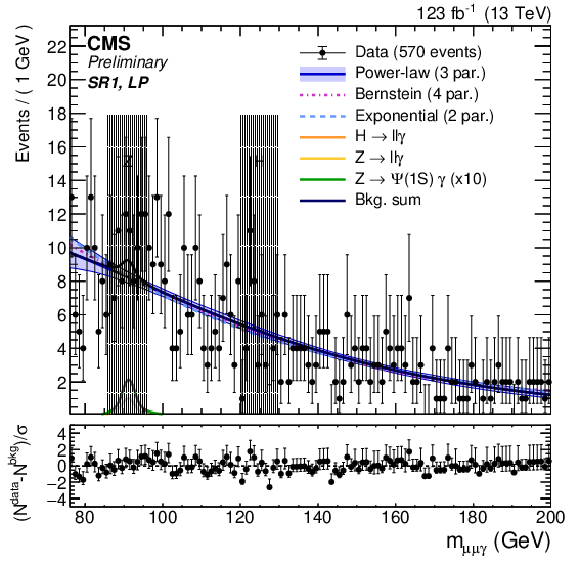
png pdf |
Figure 3-b:
Background-only fit using the power-law, exponential, and Bernstein polynomial functions with the optimal number of parameters determined with the F-test, and ranked according to the fit $ \chi^2 $. The resonant background contributions are added with normalization fixed to the SM expectation. Top left: $ \mathrm{Z}\to\psi $ (1S) $ \gamma $ HP category. Top right: $ \mathrm{Z}\to\psi $ (1S) $ \gamma $ LP category. Bottom left: $ \mathrm{H}\to\psi $ (2S) $ \gamma $ category. Bottom right: $ \mathrm{Z}\to\psi $ (2S) $ \gamma $ category. |

png pdf |
Figure 3-c:
Background-only fit using the power-law, exponential, and Bernstein polynomial functions with the optimal number of parameters determined with the F-test, and ranked according to the fit $ \chi^2 $. The resonant background contributions are added with normalization fixed to the SM expectation. Top left: $ \mathrm{Z}\to\psi $ (1S) $ \gamma $ HP category. Top right: $ \mathrm{Z}\to\psi $ (1S) $ \gamma $ LP category. Bottom left: $ \mathrm{H}\to\psi $ (2S) $ \gamma $ category. Bottom right: $ \mathrm{Z}\to\psi $ (2S) $ \gamma $ category. |

png pdf |
Figure 3-d:
Background-only fit using the power-law, exponential, and Bernstein polynomial functions with the optimal number of parameters determined with the F-test, and ranked according to the fit $ \chi^2 $. The resonant background contributions are added with normalization fixed to the SM expectation. Top left: $ \mathrm{Z}\to\psi $ (1S) $ \gamma $ HP category. Top right: $ \mathrm{Z}\to\psi $ (1S) $ \gamma $ LP category. Bottom left: $ \mathrm{H}\to\psi $ (2S) $ \gamma $ category. Bottom right: $ \mathrm{Z}\to\psi $ (2S) $ \gamma $ category. |

png pdf |
Figure 4:
Results of the main background fit in the CR, using the power-law, exponential, and Bernstein polynomial functions with the optimal number of parameters determined with the F-test. |

png pdf |
Figure 5:
Observed and expected (with $ {\pm}1,\,{\pm} $ 2 standard deviation bands) exclusion limits on the branching fraction of the $ (\mathrm{H},\mathrm{Z}) \to \psi $ (nS) $ \gamma $ processes. |
| Tables | |

png pdf |
Table 1:
SM predictions of the branching fractions of the Higgs and Z bosons to $ \psi $ (nS) $ \gamma $, and measured branching fractions for the $ \psi $ (nS) $ \to\mu\mu $ decays [12]. |
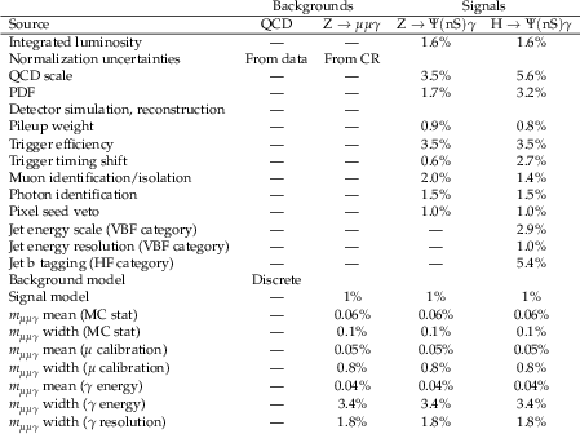
png pdf |
Table 2:
Sources of systematic uncertainties described in Section 6 and their impact on the signal strength. |

png pdf |
Table 3:
Observed (expected) upper limits at 95% CL on the product of the cross section and the branching fraction of the $ (\mathrm{H},\mathrm{Z}) \to \psi $ (nS) $ \gamma $ processes. The normalized values with respect to the SM expectation are included as well and denoted as the signal strength parameter $ \mu $. The results are compared with previous ones [13,15]. |
| Summary |
| A search for the rare decays of the Z and H bosons to a photon and a $ \psi $ (nS) meson decaying to a pair of muons is presented. No statistically-significant excess has been observed over the standard model expectations. The data were collected by the CMS experiment at $ \sqrt{s}= $ 13 TeV during 2016--2018 and correspond to an integrated luminosity of 123 fb$ ^{-1} $. The upper limits on the branching fraction are set to 0.6 and 1.3 $ \times 10^{-6} $ for the $ \mathrm{Z}\to\psi $ (1S) $ \gamma $ and $ \mathrm{Z}\to\psi $ (2S) $ \gamma $ decays, and 2.6 and 9.9 $ \times 10^{-4} $ for the $ \mathrm{H}\to\psi $ (1S) $ \gamma $ and $ \mathrm{H}\to\psi $ (2S) $ \gamma $ decays, respectively. The limit for $ \mathrm{H}\to\psi $ (1S) $ \gamma $ translates to an interval constraint on the $ \kappa_{c}/\kappa_{\gamma} $ ratio of the Higgs boson coupling modifiers of $ (-157, +199) $; if the SM value of $ \kappa_{\gamma}= $ 1 is assumed, the observed interval is $ (-166,+208) $. |
| References | ||||
| 1 | ATLAS Collaboration | Observation of a new particle in the search for the standard model Higgs boson with the ATLAS detector at the LHC | PLB 716 (2012) 1 | 1207.7214 |
| 2 | CMS Collaboration | Observation of a new boson at a mass of 125 GeV with the CMS experiment at the LHC | PLB 716 (2012) 30 | CMS-HIG-12-028 1207.7235 |
| 3 | CMS Collaboration | Observation of a new boson with mass near 125 GeV in pp collisions at $ \sqrt{s} $ = 7 and 8 TeV | JHEP 06 (2013) 081 | CMS-HIG-12-036 1303.4571 |
| 4 | F. Englert and R. Brout | Broken symmetry and the mass of gauge vector mesons | PRL 13 (1964) | |
| 5 | P. W. Higgs | Broken symmetries and the masses of gauge bosons | PRL 13 (1964) | |
| 6 | CMS Collaboration | A portrait of the Higgs boson by the CMS experiment ten years after the discovery. | Nature 607 (2022) | CMS-HIG-22-001 2207.00043 |
| 7 | ATLAS Collaboration | A detailed map of Higgs boson interactions by the ATLAS experiment ten years after the discovery | Nature 607 (2022) | 2207.00092 |
| 8 | LHC Higgs Cross Section Working Group Collaboration | Handbook of LHC Higgs Cross Sections: 4. Deciphering the Nature of the Higgs Sector | link | 1610.07922 |
| 9 | G. T. Bodwin, H. S. Chung, J.-H. Ee, and J. Lee | $ Z $-boson decays to a vector quarkonium plus a photon | PRD 97 (2018) | 1709.09320 |
| 10 | G. T. Bodwin, H. S. Chung, J.-H. Ee, and J. Lee | Addendum: New approach to the resummation of logarithms in Higgs-boson decays to a vector quarkonium plus a photon [Phys. Rev. D 95, 054018 (2017)] | PRD 96 (2017) | 1710.09872 |
| 11 | N. Brambilla et al. | Order $ v^4 $ corrections to Higgs boson decay into $ J/\psi + \gamma $ | PRD 100 (2019) | 1907.06473 |
| 12 | Particle Data Group Collaboration | Review of Particle Physics | PTEP 2022 (2022) | |
| 13 | CMS Collaboration | Search for rare decays of Z and Higgs bosons to J$ /\psi $ and a photon in proton-proton collisions at $ \sqrt{s} = $ 13 TeV | EPJC 79 (2019) 94 | CMS-SMP-17-012 1810.10056 |
| 14 | ATLAS Collaboration | Searches for exclusive Higgs and Z boson decays into $ J/\psi\gamma $, $ \psi(2S)\gamma $, and $ \Upsilon(nS)\gamma $ at $ \sqrt{s}= $ 13 TeV with the ATLAS detector | PLB 786 (2018) 134 | 1807.00802 |
| 15 | ATLAS Collaboration | Searches for exclusive Higgs and Z boson decays into a vector quarkonium state and a photon using 139 fb$ ^{-1} $ of ATLAS $ \sqrt{s}= $ 13 TeV proton-proton collision data | EPJC 83 (2023) 781 | 2208.03122 |
| 16 | CMS Collaboration | The CMS experiment at the CERN LHC | JINST 3 (2008) S08004 | |
| 17 | CMS Collaboration | Description and performance of track and primary-vertex reconstruction with the CMS tracker | JINST 9 (2014) P10009 | CMS-TRK-11-001 1405.6569 |
| 18 | CMS Collaboration | Performance of the CMS Level-1 trigger in proton-proton collisions at $ \sqrt{s} = $ 13 TeV | JINST 15 (2020) P10017 | CMS-TRG-17-001 2006.10165 |
| 19 | CMS Collaboration | The CMS trigger system | JINST 12 (2017) P01020 | CMS-TRG-12-001 1609.02366 |
| 20 | J. Alwall et al. | The automated computation of tree-level and next-to-leading order differential cross sections, and their matching to parton shower simulations | JHEP 07 (2014) 079 | 1405.0301 |
| 21 | M. König and M. Neubert | Exclusive Radiative Higgs Decays as Probes of Light-Quark Yukawa Couplings | JHEP 08 (2015) 012 | 1505.03870 |
| 22 | Y. Li and F. Petriello | Combining QCD and electroweak corrections to dilepton production in FEWZ | PRD 86 (2012) 094034 | 1208.5967 |
| 23 | CMS Collaboration | Extraction and validation of a new set of CMS PYTHIA8 tunes from underlying-event measurements | EPJC 80 (2020) 4 | CMS-GEN-17-001 1903.12179 |
| 24 | R. D. Ball et al. | Parton distributions with QED corrections | NPB 877 (2013) 290 | 1308.0598 |
| 25 | R. D. Ball et al. | Unbiased global determination of parton distributions and their uncertainties at NNLO and at LO | NPB 855 (2012) 153 | 1107.2652 |
| 26 | GEANT4 Collaboration | GEANT 4---a simulation toolkit | NIM A 506 (2003) 250 | |
| 27 | CMS Collaboration | Particle-flow reconstruction and global event description with the CMS detector | JINST 12 (2017) P10003 | CMS-PRF-14-001 1706.04965 |
| 28 | M. Cacciari, G. P. Salam, and G. Soyez | The anti-$ k_{\mathrm{T}} $ jet clustering algorithm | JHEP 04 (2008) 063 | 0802.1189 |
| 29 | M. Cacciari, G. P. Salam, and G. Soyez | FastJet user manual | EPJC 72 (2012) 1896 | 1111.6097 |
| 30 | M. Cacciari, G. P. Salam, and G. Soyez | The catchment area of jets | JHEP 04 (2008) 005 | 0802.1188 |
| 31 | CMS Collaboration | Pileup mitigation at CMS in 13 TeV data | JINST 15 (2020) P09018 | CMS-JME-18-001 2003.00503 |
| 32 | CMS Collaboration | Identification of heavy-flavour jets with the CMS detector in pp collisions at 13 TeV | JINST 13 (2018) P05011 | CMS-BTV-16-002 1712.07158 |
| 33 | CMS Collaboration | Performance of photon reconstruction and identification with the CMS detector in proton-proton collisions at sqrt(s) = 8 TeV | JINST 10 (2015) P08010 | CMS-EGM-14-001 1502.02702 |
| 34 | CMS Collaboration | Electron and photon reconstruction and identification with the CMS experiment at the CERN LHC | JINST 16 (2021) P05014 | CMS-EGM-17-001 2012.06888 |
| 35 | CMS Collaboration | Performance of the CMS muon detector and muon reconstruction with proton-proton collisions at $ \sqrt{s}= $ 13 TeV | JINST 13 (2018) P06015 | CMS-MUO-16-001 1804.04528 |
| 36 | M. J. Oreglia | A study of the reactions $ \psi^\prime \to \gamma \gamma \psi $ | PhD thesis, Stanford University, SLAC Report SLAC-R-236, 1980 link |
|
| 37 | M. H. Kutner, C. J. Nachtsheim, J. Neter, and W. Li | Applied Linear Statistical Models | Irwin, . Fifth edition. ISBN~9780256117363, 1996 | |
| 38 | P. D. Dauncey, M. Kenzie, N. Wardle, and G. J. Davies | Handling uncertainties in background shapes: the discrete profiling method | JINST 10 (2015) P04015 | 1408.6865 |
| 39 | CMS Collaboration | Precision luminosity measurement in proton-proton collisions at $ \sqrt{s} = $ 13 TeV in 2015 and 2016 at CMS | EPJC 81 (2021) 800 | CMS-LUM-17-003 2104.01927 |
| 40 | CMS Collaboration | CMS luminosity measurement for the 2017 data-taking period at $ \sqrt{s} = $ 13 TeV | CMS Physics Analysis Summary, 2018 CMS-PAS-LUM-17-004 |
CMS-PAS-LUM-17-004 |
| 41 | CMS Collaboration | CMS luminosity measurement for the 2018 data-taking period at $ \sqrt{s} = $ 13 TeV | CMS Physics Analysis Summary, 2019 CMS-PAS-LUM-18-002 |
CMS-PAS-LUM-18-002 |
| 42 | NNPDF Collaboration | Parton distributions for the LHC Run II | JHEP 04 (2015) 040 | 1410.8849 |
| 43 | J. Butterworth et al. | PDF4LHC recommendations for LHC Run II | JPG 43 (2016) 23001 | 1510.03865 |
| 44 | CMS and ATLAS Collaborations | Procedure for the LHC Higgs boson search combination in Summer 2011 | CMS Note CMS-NOTE-2011-005, ATL-PHYS-PUB-2011-11, 2011 | |
| 45 | T. Junk | Confidence level computation for combining searches with small statistics | NIM A 434 (1999) 435 | hep-ex/9902006 |
| 46 | A. L. Read | Presentation of search results: the CL$ _{\mathrm{s}} $ technique | JPG 28 (2002) 2693 | |
| 47 | G. Cowan, K. Cranmer, E. Gross, and O. Vitells | Asymptotic formulae for likelihood-based tests of new physics | EPJC 71 (2011) 1554 | 1007.1727 |
| 48 | LHC Higgs Cross Section Working Group | Handbook of LHC Higgs Cross Sections: 3. Higgs Properties | CERN-2013-004, 2013 link |
1307.1347 |
| 49 | CMS Collaboration | Measurements of Higgs boson production cross sections and couplings in the diphoton decay channel at $ \sqrt{\mathrm{s}} $ = 13 TeV | JHEP 07 (2021) 027 | CMS-HIG-19-015 2103.06956 |
| 50 | G. Perez, Y. Soreq, E. Stamou, and K. Tobioka | Constraining the charm Yukawa and Higgs-quark coupling universality | PRD 92 (2015) 033016 | 1503.00290 |

|
Compact Muon Solenoid LHC, CERN |

|

|

|

|

|

|